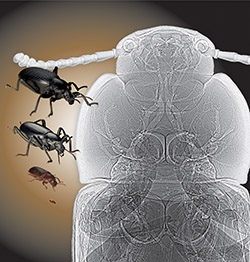Aug 10 2007
Researchers at the U.S. Department of Energy's Argonne National Laboratory have cast new light on why the giant insects that lived millions of years ago disappeared.
 X-ray imaging of beetles helps confirm that tracheal system design may limit size in insects. More of the body is filled with air-filled tracheal tubes in larger species, particularly in the legs, and so much larger species than exist today might not have room for enough tubes.
X-ray imaging of beetles helps confirm that tracheal system design may limit size in insects. More of the body is filled with air-filled tracheal tubes in larger species, particularly in the legs, and so much larger species than exist today might not have room for enough tubes.
In the late Paleozoic Era, with atmospheric oxygen levels reaching record highs, some insects evolved into giants. When oxygen levels returned to lower levels, the insect giants went extinct.
The basis of this gigantism is thought to lie in the insect respiratory system. In contrast to vertebrates, where blood transports oxygen from the lung to the cell, insects deliver oxygen directly through a network of blind-ending tracheal tubes. As insects get bigger, this type of oxygen transport becomes far less effective. But if the atmospheric oxygen levels increase, as they did in the late Paleozoic, then longer tracheal tubes can work. This would allow larger-sized insects - even giants - to evolve.
Recent research published in the journal Proceedings of the National Academy of Science helps confirm the hypothesis that the tracheal system actually limits how big insects can be. The research provides a specific explanation for what limits size in beetles: the constriction leading to the legs.
A collaborative team of researchers from Argonne's Advanced Photon Source (APS), Midwestern University and Arizona State University wanted to study how beetles' tracheal systems change as their body sizes increase. The team took advantage of richly detailed X-ray images they produced at the APS to examine the dimensions of tracheal tubes in four beetle species, ranging in body mass by a factor of 1,000.
Overall, they found that larger beetle species devote a disproportionately greater fraction of their body to tracheal tubes than do smaller species.
The team focused in particular on the passageways that lead from the body core to the head and to the legs. They reasoned that these orifices may be bottlenecks for tracheal tubes, limiting how much oxygen can be delivered to the extremities.
“We were surprised to find that the effect is most pronounced in the orifices leading to the legs, where more and more of the space is taken up by tracheal tubes in larger species,” said Alex Kaiser, biologist at Midwestern University.
They then examined the tracheal measurements of the four species to see if they could predict the largest size of currently living beetles. The head data predicted an unrealistically large, foot-long beetle. In contrast, the leg data predicted a beetle that nicely matches the size of the largest living beetle, Titaneus giganteus.
“This study is a first step toward understanding what controls body size in insects. It's the legs that count in the beetles studied here, but what matters for the other hundreds of thousands of beetle species and millions of insect species overall is still an open question,” said Jake Socha, Argonne biologist.